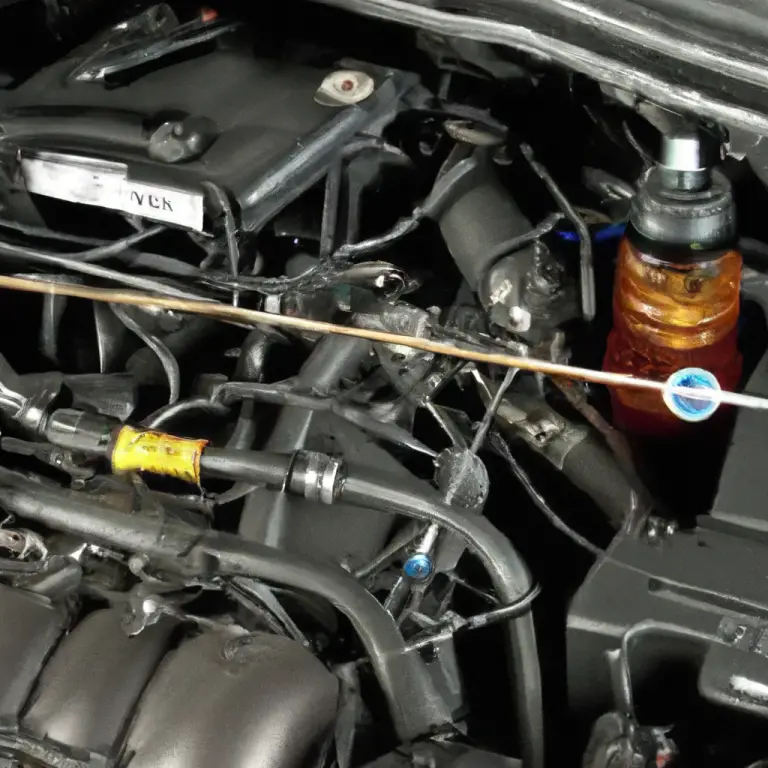2017 Ford Escape Coolant Leak Recall
Last Updated on by Axle McRoad
In this article, I will be discussing an important topic of the automotive world – the 2017 Ford Escape coolant leak recall. This information is vital for Ford owners, mechanics, DIY enthusiasts, and anyone involved in Ford maintenance. The discussion is centered around the intricate details of the said recall, aiming to provide valuable repair insights and help you understand its real-life implications. I will also be integrating high-quality images, links, and a helpful FAQs section to give you a comprehensive picture of this issue. So without further ado, let’s gear up for an informative exploration into the world of Ford and its vehicle maintenance.

Background of the 2017 Ford Escape Coolant Leak Recall
In the automotive world, recalls are not unfamiliar. They are, however, always met with widespread concern due to the implications for both the vehicle owners and the car manufacturer. One prominent instance of such a recall was concerning the 2017 Ford Escape.
Description of the coolant leak issue
The crux of this issue resided in a malformation in the engine compartment, leading to a loss of coolant. This unfortunate mishap ran the risk of causing cylinders to overheat, potentially leading to engine fractures and even oil leaks. If left unaddressed, this coolant leak could cause a puff of white smoke out of the exhaust and the catastrophic end could be a complete engine failure or a fire in extreme circumstances.
Impacted Ford Escape models
The primary model affected by this issue was the 2017 Ford Escape. It wasn’t just a few vehicles that were at risk but, in fact, a staggering 230,000 vehicles were found to be potentially harmed by this issue throughout the United States, Canada, and Mexico.
Official statement by Ford
Ford, understanding the magnitude of the situation, issued a statement, acknowledging the fault in the engine compartment that led to the coolant leak. They stressed on the importance of handling the situation responsibly and demonstrated their commitment to the safety of their customers by initiating a recall for all potentially impacted vehicles.
Understanding the Coolant System
What is a coolant
In a car, a coolant is a mixture of an antifreeze fluid and water. This substance is indispensable to the smooth operation of the vehicle, as it maintains engine temperature within a specified range, preventing overheating.
Function of coolant in a vehicle
The primary function of the coolant is to absorb excessive heat from the engine and diffuse it through the radiator. Without it, the engine would overheat, causing severe damage to the engine components and potentially leading to a complete engine failure.
How a leak affects the overall health of a vehicle
A coolant leak does not only pose an immediate risk of engine overheating but also severely affects other aspects of the vehicle. It can lead to accumulation of rust and corrosion in the engine, degrade rubber hoses and seals, and significantly reduce overall engine efficiency and performance.
Implications of the Coolant Leak
Effects of a coolant leak on engine performance
When a coolant leak occurs, the engine can overheat continuously, leading to warped components and blown gaskets. It may cause the engine to run roughly, misfire, or completely fail, significantly affecting the vehicle’s performance and drivability.
Potential safety risks due to coolant leak
If the coolant leak is not addressed in a timely manner, it can pose severe safety risks. The engine may stall or fail while driving, which can lead to accidents, especially at high speeds. In extreme cases, it may also cause a fire in the engine compartment due to the excessively high temperature.
Environmental implications of coolant leak
A coolant leak is not just bad for your vehicle, it’s also harmful to the environment. Antifreeze is a toxic substance and its leak can contaminate soil and water, posing a significant threat to wildlife, especially to small animals and birds who could ingest it.

Diagnosis and Identification of a Coolant Leak
How to identify a coolant leak
Identifying a coolant leak can be relatively straightforward. You may observe a brightly colored fluid pooling beneath your vehicle, or experience issues such as an overheating engine or an illuminated check engine light.
Signs of a possible coolant leak in a Ford Escape
In a Ford Escape, particularly the 2017 model, suspected issues such as engine overheating, frequent need to refill the coolant, or visible signs of a leak beneath the vehicle may be indicative of a coolant leak and should not be ignored.
Necessary tools for diagnosing a coolant leak
Several tools can be used to diagnose a coolant leak effectively. These include a pressure tester to check the cooling system for leaks, a UV leak detection kit to find small or hard-to-locate leaks, and a multimeter to check for instances of electrical corrosion that might be causing the leak.
The Recall Process
How Ford found out the problem
Ford was notified of the issue after multiple reports from customers, particularly instances of engine overheating and vehicle fires specifically linked to the coolant leak. They performed an internal investigation and upon confirming the issue they decided to initiate the recall.
Reaction of Ford towards the issue
Ford’s response was prompt, demonstrating their commitment to customer safety. They initiated a massive recall to address the coolant leak issue in all potentially affected vehicles. While acknowledging the problem was a bold move, Ford adhered to protocol and maintained transparency throughout the process.
Process of communicating the recall to customers
To communicate the recall, Ford leveraged several channels of communication. They directly reached out to affected customers, issued press releases, and made use of dealer networks to spread the information.
Going through the Recall Process
Steps to take if your vehicle is part of the recall
If your 2017 Ford escape were a part of this recall, the first step would be to respond promptly, and to get in touch with your nearest Ford dealership. They would then schedule an appointment to fix the issue, free of charge.
Paperwork and documentation needed for the recall process
When you receive a recall notification, it’s crucial to keep it safe. You may need to provide this notice, along with other documents like your vehicle’s registration and proof of ownership, at the dealership where the repair is being carried out.
Possible delays or issues that may arise during the recall
While recalls are typically straightforward, certain unexpected issues or delays can occur due to multiple reasons like shortage of replacement parts, backlog of recall repairs, or unforeseen complications during the repair process. It’s crucial to maintain communication with your dealership to stay updated.
Technical Process for Fixing the Coolant Leak
Steps a mechanic would take to address the coolant leak
Depending on the cause of the leak, the mechanic may tighten loose connections, replace faulty hoses or clamps, or install a new water pump. In severe cases, if the leak has led to damage to the engine, more extensive repairs may be required.
Estimated time for the repair
The duration of the repair process largely depends on the extent of the damage caused by the coolant leak. However, on average, the process can take anywhere from one to three days.
Components that may need to be replaced as part of the repair
Various components may need to be replaced depending on the nature of the coolant leak. This could include the water pump, the radiator, the heater core, or the coolant hoses among others.
Buyer Awareness
What potential buyers of a 2017 Ford Escape should be aware of
Potential buyers should be aware of the coolant leak recall issue before purchasing a used 2017 Ford Escape. It is crucial to verify if the particular vehicle was part of the recall and if the coolant leak issue has been adequately addressed.
Information that sellers should disclose to potential buyers
Ethical car sellers should disclose the known issues, especially those serious enough to warrant a recall, of the vehicle they are selling. They should make the potential buyer aware of the coolant leak issue and provide the relevant repair records.
Checking if a used 2017 Ford Escape has been part of the recall
One can check if a used vehicle has been part of a recall by using the Vehicle Identification Number (VIN) of the vehicle. This can be checked against the National Highway Traffic Safety Administration (NHTSA) database or directly with Ford.
Preventing Future Coolant Leaks
Routine checks for coolant leak
Implementing a routine to regularly check for coolant leaks will catch the issue early before it becomes significant. Look for signs of a leak, keep an eye on the coolant level, and watch out for signs of engine overheating.
Other preventive maintenance tips
Apart from being on the lookout for coolant leaks, other preventive measures like regular oil and filter changes, checking and replacing worn-out components, and timely servicing can help ensure the health of your vehicle.
Recommended service schedule for Ford Escape
Adhering to Ford’s recommended service schedule for your Escape is absolutely crucial. Regular maintenance checks every 10,000 miles and more detailed inspections every 30,000 miles can help identify issues early and prolong the life of your vehicle.
Conclusion: Lessons from the 2017 Ford Escape Coolant Leak Recall
The 2017 Ford Escape coolant leak recall serves as a reminder of how integral vehicle maintenance is. It emphasizes how vital it is for car manufacturers to take any issues reported by their customers seriously, and how important it is for vehicle owners to respond promptly to recall notices. It also sheds light on the necessity of routine checks for coolant leaks, and the importance of adhering to the manufacturer’s recommended service schedule. Finally, it underscores how vital it is for buyers to research any potential recall issues before purchasing a used vehicle.
In the aftermath of the recall, Ford has taken actions to improve their quality control and has focused on rebuilding their customer trust by ensuring such issues do not arise in future vehicle iterations. All in all, while the situation was regrettable, it provided valuable lessons and areas of improvement for both consumers and automakers alike.




